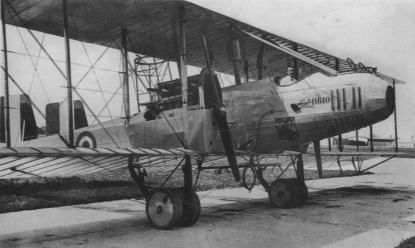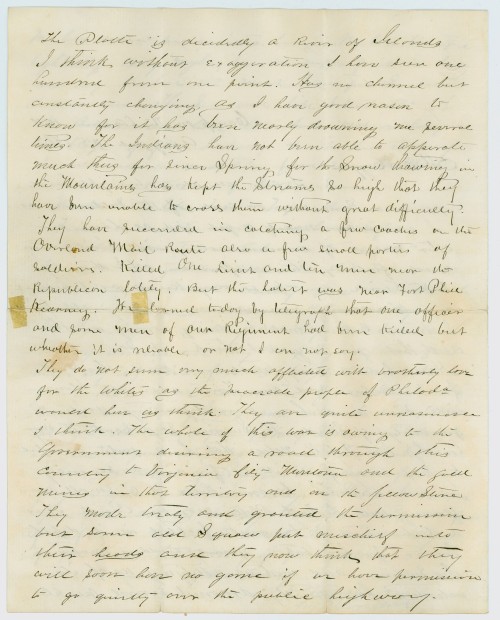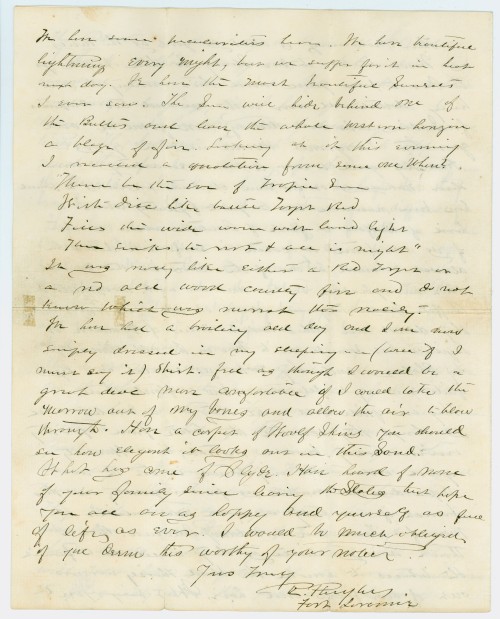By: Jessica Cosgrove
At approximately 6:15 p.m. on December 6, 1944 three men and one woman at Ben Goe coal mine west of Thermopolis witnessed a strange event. They saw a parachute in the air with lit flares, a few moments later they heard a whistling noise then the sound of an explosion. They saw smoke rising from a draw near the mine. Notified of the event Sheriff Kem Moyer proceeded to investigate that night and into the following day. He searched for a man believed to be with the parachute; no man was found but something else was. Moyer told the Thermopolis Independent Record a heavy bomb had exploded leaving its fragments behind about a mile and a half from the mine, near the Meeteetse-Thermopolis highway.[1]

When word of the bomb fragments reached Casper Air Base an investigator for the base was dispatched to Thermopolis to investigate the incident. The investigator sent the fragments to Casper to be examined and the word came back that no bombs of this make were in Casper. The investigator flew over the area where the reported parachute was spotted. He did not find any sign of a parachute. Louis Artman, a sheep herder, claimed to have seen a parachute land in an area Northwest of Thermopolis and stated that the flares burned for at least ten minutes. The base investigator came back out to fly the area a second time, but no parachute was found.[2]
Finally, the search for the parachute was called off by Sheriff Moyer. The running theory was that the parachute seen was a landing flare. No planes were heard or seen the night the bomb exploded, and no planes were reported missing. Some claim a plane that can carry the type of bomb dropped could be flown so high it would neither be seen nor heard. [3]
This bomb did not come from a careless United States pilot. This bomb came from, in the time of 1944, a far more sinister force. The bomb came from Japan.
Six days after the bomb incident in Thermopolis on December 12, 1944 a large paper balloon with Japanese ideographs and armed with incendiary bombs capable of starting a major wildfire was found 17 miles southwest of Kalispell, Montana. The Federal Bureau of Investigation was dispatched to investigate the balloon and warned the Kalispell population not to talk about the balloon. The five hundred people who saw the balloon heeded the FBI’s warnings. The entire town clammed up about this incident because they all had sons and husbands in the service and did not want to give away valuable information to the enemy. This censorship expanded to the rest of the country. Not many people knew about the balloon bombs except for law enforcement, newspaper writers, and publishers.[4]
On May 22, 1945 the Laramie Republican Boomerang ran an Associated Press story stating the Japanese had been making an effort to bomb the western U.S. mainland with unmanned balloons. The article stated: “The balloons, which carry a few small bombs, were described as being of gray, white or greenish-blue paper and about 33 feet in diameter. The main purpose of the bombs, it was said, is believed to be to set brush and forest fires. The balloons are unmanned and cannot be controlled by the enemy.”[5] The war and navy department also stated negligible damage had been done; but some of the balloons had landed or dropped explosives in isolated sections of the country, like in Thermopolis, Wyoming.[6]
In an August 22, 1945 article found in the Cody Enterprise the stories of these balloons over Wyoming finally started to come out. According to unofficial reports at least 16 of the bombs bearing Pacific crossing balloons were sighted or landed in Wyoming. One of the first reported sightings was in Thermopolis. The last reported sighting was near Cheyenne where residents reported to see what they claimed to be a “Jap balloon.” This particular sighting took place in June of 1945. Other sightings came from Cody, where on January 15, 1945 people claimed to have spotted a balloon over the Cody refinery. Another was reported on February 8, 1945 by Kenneth Adkins about 25 miles west of Newcastle. This balloon was taken to Newcastle and placed under guard in a state armory. On February 22, 1945 a former Park County Treasurer by the name of Harry Barrows and several others heard an explosion and felt the concussion near Ralston. [7]
According to T.A. Larson’s book Wyoming’s War Years: 1941-1945, Japanese officials who were interviewed after the war claimed the balloon bombs were a reaction to the Doolittle fire bombings in Tokyo, April 18, 1942. There were two years of experimentation before 9,000 balloons were launched from three sites near Tokyo. This mission cost the Japanese $2,000,000. Due to a lack of evidence of success the operation was deemed a failure and called off April 20, 1945. In fact, Japanese officials had only heard of one balloon landing in America. The censorship of information pertaining to these balloon bombs in the United States worked. The Japanese officers said the aim of the operation was to “create confusion by starting wildfires and frightening civilians.”[8]
An August 15, 1945 Casper Tribune Associated Press article titled “Japanese Bomb Balloons Come Down in 16 States” prove these bomb balloons were widespread across the western portion of the North American Continent. The states where a bomb balloon made land included Oregon, Washington, California, South Dakota, Idaho, North Dakota, Nevada, Utah, Colorado, Nebraska, Kansas, Texas, Iowa, Michigan, Alaska and of course Montana and Wyoming. The article also stated balloons were found in British Columbia, Alberta, Saskatchewan, Manitoba, Northwest Territory and one or two were found in Mexico.[9]
No lives were lost in Wyoming due to these Japanese balloon bombs, but Oregon wasn’t so lucky. In Lakeview, Oregon on May 5, 1945 the Japanese balloon bombs claimed six lives. Elsie Mitchell and five neighborhood children with her, Edward Engen, Sherman Shoemaker, Jay Gifford, Richard Patzke, and Ethel Patzke, were dragging the Japanese balloon out of the woods when the bombs exploded. Elsie and the children were the only civilians to be killed on the continental United States during WWII. By the end of the war with Japan approximately 500,000 Japanese civilians were killed due to bombings by the United States and its allies.[10]
[1] Thermopolis Independent Record, December 14, 1944; Thermopolis Has Airplane Mystery; Bomb Dropped Nearby
[2] ibid
[3] ibid
[4] The Laramie Republican Boomerang, December 19, 1944; Mysterious Balloon Bearing Jap Insignia and Armed with Bomb Uncovered in Montana Forest.
[5] The Laramie Republican Boomerang, May 22, 1945; Jap Efforts to Bomb Western U.S. with Balloons Is Revealed
[6] ibid
[7] The Cody Enterprise, August 22, 1945; Story of Jap Balloons Over Wyoming Being Told by Informed Press
[8] T.A.Larson, Wyoming’s War Years: 1941-1945 p76-78 (Stanford: Stanford University Press,1954)
[9] Casper Tribune, August 15, 1945; Japanese Bomb Balloons Come Down in 16 States
[10] History.com Editors, Six killed in Oregon by Japanese bomb, February 9, 2010; https://www.history.com/this-day-in-history/six-killed-in-oregon-by-japanese-bomb







 To determine whether these records may contain some of your ancestors, start with the Federal Census prior to and following WWI. Information contained on the 1910 federal census can assist you in determining an ancestor’s citizenship prior to WWI Enemy Alien Registration. As a follow-up, the 1920 census specifically asks the year of naturalization. Through deciphering information from both returns an ancestor’s 1918 citizenship status may be determined. All open U.S. census returns are available via AncestryLibrary.com in all Wyoming libraries.
To determine whether these records may contain some of your ancestors, start with the Federal Census prior to and following WWI. Information contained on the 1910 federal census can assist you in determining an ancestor’s citizenship prior to WWI Enemy Alien Registration. As a follow-up, the 1920 census specifically asks the year of naturalization. Through deciphering information from both returns an ancestor’s 1918 citizenship status may be determined. All open U.S. census returns are available via AncestryLibrary.com in all Wyoming libraries.  provides reports of actions being taken not only locally but in other countries and across the US. In April 1917, various Wyoming newspapers reported how New York police officers directed all enemy aliens to turn over all firearms. An October 1917 Park County Enterprise reports how many American women, through marriage were now perceived as potential enemies, – even Gloria Vanderbilt. In December 1917, a Newcastle man was held for federal authorities, after making seditious talk. Various April and May 1920 Laramie newspapers reported on a German born male, who had registered as an enemy alien and had illegally voted in a local election.
provides reports of actions being taken not only locally but in other countries and across the US. In April 1917, various Wyoming newspapers reported how New York police officers directed all enemy aliens to turn over all firearms. An October 1917 Park County Enterprise reports how many American women, through marriage were now perceived as potential enemies, – even Gloria Vanderbilt. In December 1917, a Newcastle man was held for federal authorities, after making seditious talk. Various April and May 1920 Laramie newspapers reported on a German born male, who had registered as an enemy alien and had illegally voted in a local election.



 In his post-game commentary, Gowdy asked what “intangible something” underdogs possess that enabled them to pull off the unexpected. “That intangible something is team spirit… That team spirit must originate within the players themselves” and be fostered by the coaches. Gowdy’s credit started at the top with the fort’s commanding officer Brigadier General H.L. Whittaker for fostering participation in team sports on base and continuing to the coaches, who he praised for preparing the team to tackle what he argued was “one of the toughest schedules in the entire nation.” He ended with lavish praise of the team themselves:
In his post-game commentary, Gowdy asked what “intangible something” underdogs possess that enabled them to pull off the unexpected. “That intangible something is team spirit… That team spirit must originate within the players themselves” and be fostered by the coaches. Gowdy’s credit started at the top with the fort’s commanding officer Brigadier General H.L. Whittaker for fostering participation in team sports on base and continuing to the coaches, who he praised for preparing the team to tackle what he argued was “one of the toughest schedules in the entire nation.” He ended with lavish praise of the team themselves:
























